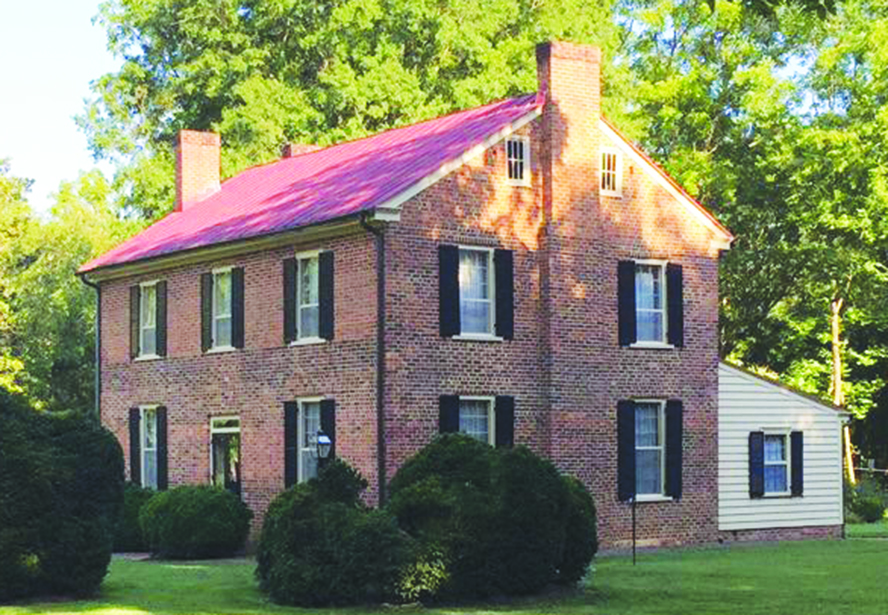The Literary Corner: Renegade Writer’s Guild
Published 2:58 pm Tuesday, December 12, 2023

- Jesse Clement house.
|
Getting your Trinity Audio player ready...
|
Revolutionary War Patriots
By Linda H. Barnette
In order to qualify for membership in DAR, Daughters of the American Revolution, one must have extensive documentation of kinship with an ancestor who fought in the war. In other words, the relationship must be proved. Many kinds of documents can be used, such as wills, deeds, marriage records, Bible records, and information on gravestones. Last year I was approved through my relationship to one Zachariah Jacobs, whose son Amos married Elizabeth Summers and had a daughter, Jerusha Jacobs, who married James Ledbetter Bowles and was the mother of my great-grandmother, Lovie Belle Bowles Dwiggins.
Trending
Although each DAR chapter has registrars who will gladly help members with research, I naturally decided on my own to look for other family members who also fought in the Revolution.
One such individual was Richard Hartley, who was born in Shrewsbury, Shropshire, England, around 1735 and died in Rowan County sometime around 1800. His is one of the most interesting genealogies that I have ever worked on. Most people agree that he was born in England and came to Maryland where he married one Abigail Becket around 1750. Although I’m not sure exactly when they came to North Carolina, I do know from the Rowan County Deed books that he bought 300 acres of land on Potts Creek in what is now Davidson County in the area of Jersey Church. I also know that he served as the keeper of the Salisbury jail during the war, thus qualifying for a pension. But I am missing the necessary documentation to prove his relationship to me.
One more patriot in my group was Benjamin Bowles, who is actually related to my great-grandmother. He was born in Virginia around 1760 and came to Montgomery County where he enlisted in the army and became somewhat of a hero. One of my grandmother’s cousins had a monument in his honor placed in the cemetery of his burial in Montgomery County. Again, I have not been able to document my relationship to him.
Thus, all of this just gives me another project to work on!!
Holiday Memories
Trending
By: E. Bishop
And the Christmas mouse race begins for those of us who believe. No perfect holiday exists for everyone; this time of year can be extremely painful and lonely for some people so let’s remember those when we come together with friends and family to celebrate. Dr. Suess’s quote about this time of year is a favorite “Christmas will always be as long as we stand heart to heart and hand in hand.” Think of ways to go hand in hand with those less fortunate and spread the love while creating memories for yourself and others.
Memories enrich our lives whether we realize it or not. We never know when the simplest thing will be the most memorable in years to come. What’s under the tree will not always be it either. The smells, the excitement, the anticipation will transport you back to childhood when all things seemed much simpler and beautiful.
Growing up on a farm in a two-story house using wood stoves for cooking and heating helped form my childhood memories for sure. Several things come to mind. Our mother always baked a coconut cake; she was an expert in baking with that wood cookstove. Do you know how difficult it is to crack a whole coconut (how do monkeys do it)? First, you have to beat it with a hammer until it cracks, then punch a hole in the eye, drain the milk out which will be poured over the baked cake, peel/cut off that covering and then grate the coconut. Watch out or you will slice a finger or two. But, it was so worth it. Walking the farm to collect holly, running cedar, mistletoe and the perfect cedar tree to decorate will always be a favorite memory of mine. I still love to get out and walk in the woods. Of course, the Christmas Eve church service with a bag of goodies and riding around looking at lights was wonderful.
One year, I made the mistake of looking in the barn loft for presents. Found that babydoll but was it as special come Christmas morn? Can’t remember; probably was though. Another year, I stole a very special pint jar of golden honey from the cupboard. My father had just robbed the beehives that fall, and I happened to think this one certain jar would make a wonderful Christmas gift for my most favorite teacher, Ms. Agnes Sanford Leary. Ms. Leary gave up being a commercial artist when she got married, came back to Davie County and taught second grade at Cooleemee School for 25 years. Who else has memories of this sweet lady?
The past few years have been more difficult to get together with all of our extended family and friends. But no matter, we have those lasting memories from years past. Hope we all will continue to cherish those, make new ones and remember that the message of Christmas is timeless – He came to give us love, hope and joy.
The Lady of the House
By Stephanie Williams Dean
I’m grateful to see such a fine Federal-style home as the Jesse A. Clement House preserved and shared with our community. Amazing are the many artistic endeavors and forms of skilled labor that it took to build such a property and to maintain it afterward.
I like to believe Jesse built the home in 1828 for his lovely bride, Melinda Nail, as they married the same year. I see a big smile on Ms. Melinda’s face in anticipation as Jesse carries her over the threshold and into their newly built, Federal-style home. I also imagine Ms. Melinda might have been instrumental in a few of the decisions relating to the design and décor of the home.
I suspect that the soon-to-be-married lady might have visited the homesite and watched the gathering of straw and yellow corn to mix with water to make bricks. She must have taken great delight in seeing pigs churn the mixture to create the mud that later formed the more decorative of those bricks. It could have been Ms. Melinda’s idea to consider building two more decorative, Flemish-style walls that faced guests as they dropped by to visit. Most likely, aesthetics would be high on a woman’s priority list!
I see Mr. Jesse riding home to his 200-acre plantation in the country after a long day of politics – turning into a grand entrance of maple trees flanking the path leading from the road to the house. Ms. Melinda opens the door and always greets him with a pleasant smile – and as a dutiful wife, always has a warm supper ready on the fire. And any guests that might have arrived for a holiday – in the darkness, they would have seen a comforting view of roaring flames reflecting through those multi-paned, old wavy glass windows.
Warm fires with glowing embers was stoked in each of the seven, hand-built, wood-surrounded fireboxes with an attendant coming in periodically throughout the day and night to kindle, restoke, and add more logs to keep those home fires burning. And Jesse was smart enough, no doubt, to choose to fall and lumber trees that would make good burning firewood.
I wonder who came to visit and what foods Ms. Melinda chose to feed her guests. Maybe a slave or two helped in the kitchen to prepare a meal of cooked beef, potatoes, and carrots – all that came straight from an outdoor garden – with cured meats from the old smokehouse.
Imagine the excitement when Jesse returned home from hearing circuit preacher, Charles Moorman, make an impassioned plea to win souls at Bethel Church – and the Holy Spirit that stirred within Jesse! And later, the sharing and conversations with Ms. Melinda of his conversion – and the support he must have received from her. Maybe she was with Jesse and heard the preaching – and she was instrumental in their sharing of a spiritual life together. Ms. Melinda supported the opening of her and Jesse’s home for church services – and later the couple donated lumber off their property to build the first Methodist Church in downtown Mocksville. What a gracious and generous woman Ms. Melinda must have been!
Jesse took part in building roads leading from Mocksville to Lexington – and maybe one that led to his older brother John’s home, as John had a plantation home close by. Jesse was the youngest of seven children – the two brothers must have remained emotionally close to one another to build homes so near the other. The brothers and their families may have frequented each other’s homes – possibly celebrating many holidays and special family occasions together.
Jesse’s brother, John, was instrumental in presenting a bill that separated Davie County from what was then part of Rowan County, Jesse then followed in his big brother’s footsteps, also serving in the NC House of Commons later from 1838-39. Jesse most likely discussed the day’s events with Ms. Melinda – being so wise, her opinion was important to him. And, Ms. Melinda was a smart woman – smart enough that she chose to marry a respectable man!
But then difficult times came. Knowing Jesse chose to fund and organize Calvary Company F, the Davie Grays, I picture Ms. Melinda standing stoically in the front doorway of their home waving goodbye with tears flowing. As her husband and sons rode off to participate as soldiers in the war – how faithful and brave Ms. Melinda must have been to remain supportive in such uncertain times. But the hard work and support from slaves can never be minimized in Ms. Melinda’s ability to carry on in the absence of her husband!
Jesse fought in several locations, including Fredericksburg and Harpers Ferry. I can see Ms. Melinda sitting at a desk beside a window from which she stares out to the front lawn – possibly imagining the men’s return. She sits and writes many letters to emotionally support both her husband and two sons. Baxter Clegg and Jesse Lee also fought for the Confederacy and ended up as prisoners of war until after the war ended. The faith of Ms. Melinda and Jesse must have been very instrumental in helping them get through such a difficult time in their lives.
And what a vivid scene I envision during the war when George Stoneman’s troops arrived at the Clement house hoping to steal provisions – only to discover the uncooked slabs of marbled red meat from the smokehouse were spoiled. The soldiers were drooling thinking of the savory tastes they might soon enjoy. Surely it was Ms. Melinda who outsmarted those boys. Right away the soldiers discovered the meat had turned all white and was no longer edible. Yet, when the boys departed so disappointed, those in the home dusted the flour away from the meat – and began to prepare it for cooking in celebration of their retreat! What hearty snickers Ms. Melinda must have tried hard to conceal as the men departed!
Just imagine a woman left alone to keep up a 200-acre plantation during that time – all on her own and both physically and emotionally demanding. Even with a staff so helpful, Ms. Melinda had to be a strong-willed and independent woman with a good sound mind – and instinctual survival skills!
And when Ms. Melinda’s family returned home – what a celebration and homecoming that must have been! I know Ms. Melinda and her help must have cooked up the biggest feast ever to serve those tired and hungry men!
Oh, the stories I wish we knew – and the folks we knew more about. The Clement family – and the dutiful slaves and their families. The comings and the goings of the affairs of that era.
Today, with the help of NC Preservation, the Jesse A. Clement House has been restored to its current, beautiful condition. The home was put on the National Register of Historic Places in 1980.
Walking through the house, I could feel, see, and hear many stories that the historical home begs to share with guests – tales from a bygone era that warm our hearts. We leave profoundly humbled by the hardships of their era and yet, the simple, beautiful way folks faced difficult days and still managed to succeed – despite them.
The structure stands in honor of the folks of that era, the customs, the architecture, and the historic preservation that came later – it’s important to the history of Davie County.
I see Mr. Jesse riding home to his 200-acre plantation in the country after a long day of politics – turning into a grand entrance of hundreds of maple trees flanking the path leading from the road to the house. Ms. Melinda opens the door and always greets him with a pleasant smile – and a warm supper ready on the fire. And any guests that might have arrived for a holiday – in the darkness, they would have seen a comforting view of roaring flames reflecting through those multi-paned, old wavy glass windows.
I wonder who came to visit and what foods Ms. Melinda chose to feed everyone. Maybe a slave or two helped in the kitchen to prepare a meal of cooked beef, potatoes, and carrots – all that came straight from an outdoor garden – and cured meats from an old smokehouse. Oh, the stories I wish we knew and the folks we could hear about – the Clements family – and the dutiful slaves and their families; as well as the comings and the goings of the affairs of that era.
Imagine the excitement when Jesse returned home from hearing circuit preacher, Charles Moorman, make an impassioned plea to win souls at Bethel Church – and the Holy Spirit then stirred within Jesse! And later, the sharing and conversations with Ms. Melinda of his conversion – and the support he must have received from her. Maybe she was with Jesse and heard the preaching – and she was instrumental in their sharing of a spiritual life together. Ms. Melinda supported the opening of her and Jesse’s home for church services – and later the couple donated lumber off their property to build the first Methodist Church in downtown Mocksville. What a gracious and generous woman Ms. Melinda must have been!
Jesse even took part in the building of roads locally from Mocksville to Lexington – and maybe one leading to his older brother John’s home, as John had a plantation home close by. Jesse was the youngest of seven children – the two brothers must have remained emotionally close to one another to build homes so near the other. The brothers and their families may have frequented each other’s homes – possibly celebrating many holidays and special family occasions together.
Jesse’s brother, John, was instrumental in presenting a bill that separated Davie County from what was then part of Rowan County, Jesse then followed in his big brother’s footsteps, also serving in the NC House of Commons later from 1838-39. It’s obvious to me that Ms. Melinda was smart enough to choose a respectable man!
But then more difficult times came. Knowing Jesse chose to fund and organize Calvary Company F, the Davie Grays, I picture Ms. Melinda standing stoically in the front doorway of their home waving goodbye with tears flowing. As her husband and sons rode off to participate as soldiers in the war – how faithful and brave Ms. Melinda must have been to remain supportive in such scary times. And the hard work and support from slaves can never be minimized in Ms. Melinda’s ability to carry on in the absence of her husband!
Jesse fought in several locations, including Fredericksburg and Harpers Ferry. I can see Ms. Melinda sitting at a desk beside a window from which she stares out to the front lawn – possibly imagining the men’s return. She sits and writes many letters to both her husband and two sons. Baxter Clegg and Jesse Lee also fought for the Confederacy and ended up as prisoners of war until after the war ended. The faith of Jesse and Ms. Melinda must have been instrumental in helping them get through such a difficult time in their lives.
And what a vivid scene I envision during the war when George Stoneman’s troops arrived at the Clement’s home hoping to steal provisions – only to discover the uncooked slabs of marbled red meat from the smokehouse were spoiled. The soldiers were drooling thinking of the savory tastes they might soon enjoy. Surely it was Ms. Melinda who outsmarted those boys. Right away the soldiers discovered the meat had turned all white and was no longer edible. Yet, when the boys departed so disappointed, those in the home dusted the flour away from the meat – and began to prepare it for cooking in celebration of their retreat! What hearty snickers Ms. Melinda must have tried hard to conceal as the men departed!
Just imagine a woman left alone to keep up a 200-acre plantation during that era – all on her own – both physically and emotionally demanding. Even with a staff so helpful, Ms. Melinda had to be a strong-willed and independent woman with a good sound mind – and instinctual survival skills!
And when Ms. Melinda’s family returned home – what a celebration and homecoming that must have been! I know Ms. Melinda and her help must have cooked up the biggest feast ever to serve those tired and hungry men!
Today, with the help of NC Preservation, the Jesse Clements home has been restored to its current, beautiful condition. The home was put on the National Register of Historic Places in 1980.
Walking through the home, I could feel, see, and hear many stories that the historical home begs to share with guests – tales from a bygone era that warm our hearts. We leave profoundly humbled by the hardships of their era and yet, the simple, beautiful way folks faced difficult days and still succeeded – despite them.
The structure stands in honor of the folks of that era, the customs, the architecture, and the historic preservation that came later. It’s important to the history of Davie County.





